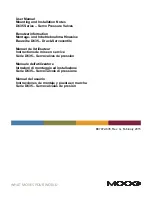
Page 2/2
Mounting and Installation Notes D635 (B97072-635-001; Version G, 02/15)
3 Installation
Compare model number and type with that specified on hy-
draulic schematic. The valve can be mounted in any position,
fixed or movable. The venting screw has to point upwards.
Mounting surface:
Check for flatness
(< 0.01 mm (0.00004 in) over 100 mm (3.94 in)) and finish
(R
a
< 0.8 µm). Care must be taken to ensure that contamina-
tion does not enter the hydraulic system, all work areas must
be clean of surface or air-borne contamination.
Mounting:
Socket head screws (grade 10.9) according to
EN ISO 4762, torque diagonally alternating.
4 Operating Pressure
Maximum operating pressure p
P
:
See nameplate.
5 Electrical Connection
Electrical safety:
The protective conductor connection is con-
nected to the electronics housing or valve body. The insulation
materials employed are designed for use in the safety extra-
low voltage range.
To comply with safety regulations requires isolation from the
mains according to EN 61558-1 and EN 61558-2-6 and limiting
all voltages according to EN 60204-1. We recommend using
SELV/PELV power supplies.
Rated signal:
See nameplate.
External fuse per valve:
1.6 A time lag
Valve phasing:
A positive signal (D–E) causes valve opening
P
A.
Connector wiring:
See wiring schematic tag attached to elec-
tronics housing, or refer to the catalog or the installation draw-
ing.
Connection:
Signal lines shielded, shielding connected at
both ends and additionally connected to reference potential
(0 V) at the control side (to improve EMC). Connect the protec-
tive conductor.
Observe technical note TN 353.
6 Hydraulic System Start Up
Pay attention to the pressure setting, the venting instructions
and the alarm messages!
7 Venting
8 Null Adjustment (Pressure)
Remove the locking screw with sealing ring from the cover of
the electronics housing to access the null adjustment potenti-
ometer. Turning the potentiometer shaft results in a spool posi-
tion or pressure change. Turning clockwise will increase valve
opening P
A or pressure. After adjustment refit the sealing
ring and the locking screw.
9 Service
Replacing O rings:
The mounting surface O rings may be re-
placed by the customer. Pay attention to cleanliness of the
valve and of the surroundings.
Transportation/storage:
Before transportation, seal the base
of the valve using a clean shipping plate or adhesive tape.
Seal the connector using a dust protection cap. Pack the valve
carefully so that it is not damaged during transportation or stor-
age.
Inspection:
Following a period of storage or no operation for
more than 5 years, we recommend that the valve is inspected
by an authorized service center, in order to prevent possible
damage.
Repairs:
Repairs may only be carried out by us or by our au-
thorized service centers.
10 Disposal
It is essential to comply with the relevant national waste dis-
posal regulations and environmental protection provisions
when disposing of valves, spare parts or accessories, packag-
ing that is no longer needed, hydraulic fluid or auxiliary materi-
als and substances used for cleaning!
NOTICE
Damage due to dirt, moisture and ozone/UV effects
• Storage outside or under the wrong climatic conditions can
cause corrosion and other damage to the valve. Conden-
sation due to temperature fluctuations can result in elec-
tronic malfunctions.
In the case of intermediate storage, observe the follow-
ing storage conditions:
• Recommended ambient temperature: +15 to +25 °C
(+60 to +78 °F), permissible temperature: –40 to
+80 °C (–40 to +176 °F), temperature fluctuation:
< 10 °C (18 °F)
• Relative humidity: < 65 % not condensing
• Ensure there are minimal vibration and shock where
valves are stored
Following transport or storage, wait until the valves have
reached ambient temperature before starting up.
• Dirt and moisture can enter the valve through openings
and cause damage. Seals can be damaged due to the
effects of ozone and UV.
During storage and transport, seal connectors with dust
protection caps and install the shipping plate on the
mounting surface.
Remove dust protection caps and shipping plate only
shortly before mounting the valves and keep packaging
materials for future storage and transport.
Seal with protection caps any valve connectors that are
not used in operation (without mating connector).
Series
Pattern to
ISO 4401
Socket
head screw
Pcs.
Torque
[Nm]
(lbf in)
D635
03-03-0-05
M5 x 55
4
6.8
WARNING
Hydraulic fluid squirting out
Hydraulic fluid squirting out under high pressure or
parts falling off can cause serious personal injuries,
burns and fires.
Only vent the valve and the actuator at a low sys-
tem pressure of max. 10 bar (145 psi).
Carefully open the venting screw by approx. one
revolution.
©
200
2, 20
03,
20
06,
2
008,
2009
, 2010
Mo
og
GmbH,
Hann
s-
Klemm-S
tr
.
28,
7103
4
B
öblin
gen,
GERMA
N
Y
, www.moo
g
.c
om
/in
dustr
ial
A
ll rig
h
ts reserved
. Sub
ject t
o
c
hange
s.






























